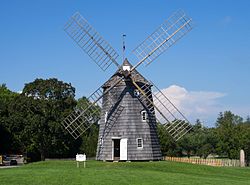
New York State Route 27 (NY 27) is a 120.58-mile (194.05 km) long state highway that runs east–west from Interstate 278 (I-278) in the New York City borough of Brooklyn to Montauk Point State Park on Long Island, New York. Its two most prominent components are Sunrise Highway and Montauk Highway, the latter of which includes the Montauk Point State Parkway. NY 27 acts as the primary east–west highway on southern Long Island east of the interchange with the Heckscher State Parkway in Islip Terrace. The entire route in Suffolk, Nassau, and Queens counties were designated by the New York State Senate as the POW/MIA Memorial Highway. The highway gives access to every town on the South Shore. NY 27 is the easternmost state route in the state of New York.
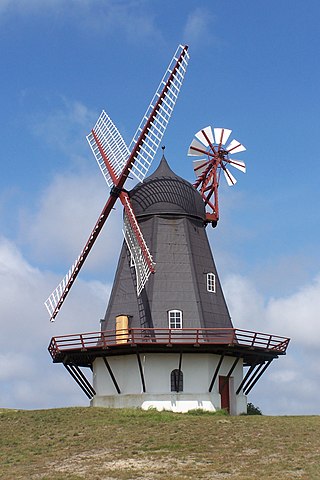
The smock mill is a type of windmill that consists of a sloping, horizontally weatherboarded, thatched, or shingled tower, usually with six or eight sides. It is topped with a roof or cap that rotates to bring the sails into the wind. This type of windmill got its name from its resemblance to smocks worn by farmers in an earlier period.

Mulford Farm in East Hampton, Long Island, New York, is one of America's most significant, intact English colonial farmsteads. The farmhouse was built in 1680 by High Sheriff Josiah Hobart, an important early official of the first New York Royal Province government. Samuel "Fish Hook" Mulford bought the property in 1712 after Hobart's death. He had the barn built in 1721. The property is listed as a contributing property of the East Hampton Village District, a historic district listed on the National Register of Historic Places.

The Fabyan Windmill is an authentic, working Dutch windmill dating from the 1850s located in Geneva, Kane County, Illinois, just north of Batavia, Illinois, off Illinois Route 25. The five-story wooden smock mill with a stage, which stands 68 feet (21 m) tall, sits upon the onetime estate of Colonel George Fabyan, but is now part of the Kane County Forest Preserve District.

Gardiners Island Windmill is a historic windmill on Gardiners Island in East Hampton, New York. The mill was added to the National Historic Register in 1978.

Hayground Windmill is an historic windmill at Windmill Lane in East Hampton Village, New York. It was moved from Hayground to Pantigo between Two Mile Hollow Beach and Egypt Beach in the 1950s.

Beebe Windmill is a historic mill located at the southeast corner of Ocean Road and Hildreth Avenue in Bridgehampton, New York.

Shelter Island Windmill is an historic windmill north of Manwaring Road in Shelter Island, Suffolk County, New York. It was built in 1810. Master Millwright Nathaniel Dominy V (1770–1852) was the architect and builder of the windmill. The windmill has been on Shelter Island since 1840 and at its current location since 1926 on the Sylvester Manor farm.

Corwith Windmill at Water Mill is a historic mill on NY 27 and Halsey Lane in Southampton, New York.

Wainscott Windmill is an historic windmill on Georgica Association grounds in Wainscott, New York in the Town of East Hampton. Georgica Association grounds are both within Wainscott and the Village of East Hampton to the east. Historically, it is known as one of the most frequently-moved windmills on the east end. It was added to the National Historic Register in 1978.

The Newlin Mill Complex, also referred to as The Newlin Grist Mill, is a water-powered gristmill on the west branch of Chester Creek near Concordville, Pennsylvania built in 1704 by Nathaniel and Mary Newlin and operated commercially until 1941. During its three centuries of operation, the mill has been known as the Lower Mill, the Markham Mill, the Seventeen-O-Four Mill and the Concord Flour Mill. In 1958 the mill property was bought by E. Mortimer Newlin, restored and given to the Nicholas Newlin Foundation to use as a historical park. Water power is still used to grind corn meal which is sold on site. The park includes five historical buildings, which were added to the National Register of Historic Places in 1983, and 150 acres (61 ha) of natural woodland.

The Pantigo Road Historic District is a historic district in the Village of East Hampton, on Long Island, New York. It is located on a segment of New York State Route 27 named Pantigo Road, and was listed on the National Register of Historic Places on July 21, 1988.

The Water MillMuseum is a historic water mill and local history museum located at 41 Old Mill Road, Water Mill in Suffolk County, New York, USA. It is a 2-story, heavy wood-frame structure with a wood-shingle exterior and composed of two building sections. There is a 2-story, square-shaped main section and 1-story, one-bay wing. Attached to the rear is a 2+1⁄2-story tower and 1-story glassed-in porch. The mill structure dates to the mid-17th century. It operated as a mill until the early 20th century. It is now a local museum.

The Windshaft is a part in a windmill that carries the sails and also the brake wheel or the head wheel and tail wheel in a Post Mill. Windshafts can be wholly made of wood, or wood with a cast iron poll end or entirely of cast iron.

American Grain Complex, also known as "The American," Russell-Miller Milling Co. Elevator, and Peavey Co. Elevator, is a historic grain elevator and flour milling complex located in South Buffalo, Buffalo, Erie County, New York. The complex consists of three contributing buildings and two contributing structures. They are the Elevator Building, Flour Building (1906-1924), office building, Moveable Marine Tower, and railroad tracks. The Elevator Building consists of the mainhouse, workhouse, and fixed marine tower, all built in 1905–1906, and an annex constructed in 1931. The complex was last owned by ConAgra Foods, who closed the elevator and mill in June 2001.
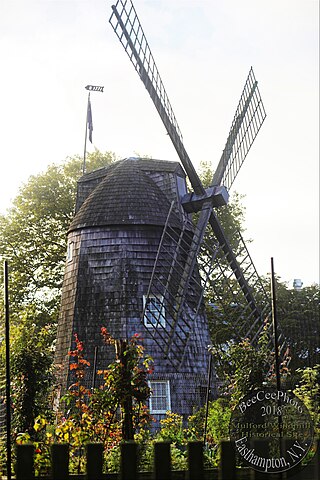
The Pantigo Windmill on James Lane in Easthampton, New York is a smock mill with eight sides, bearing a weathervane on top with 1771 punched through it. The structure was added to the National Register of Historic Places in 1984 as a contributing property of the East Hampton Village District.
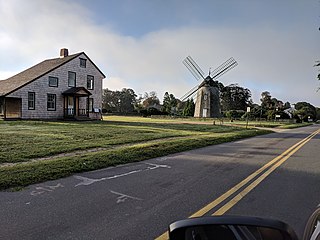
The mill cottage on the Lion Gardiner farm at 36 James Lane on the landmarked East Hampton Village green has become a museum displaying 19th and early-20th-century landscape paintings. It is a contributing structure on the NRHP East Hampton Village District, replacing the original cottage on the lot situated with the windmill and Rev James historic marker.
Goldsmith's Inlet is a tidal inlet located in the Town of Southold on the North Fork of Long Island, New York in the United States. The Peconic or Goldsmith Inlet Grist Mill had its beginnings in 1836, when plans were first made for its construction.
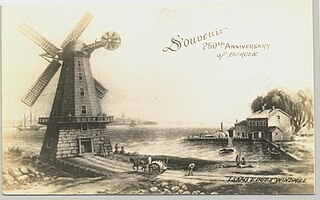
Isaac Edge's windmill is a historic landmark that played an important role in the early industrial development of Jersey City, New Jersey. Isaac Edge, a British immigrant, built the windmill in 1806 on the shore of the Hudson River, just north of the present-day corner of Montgomery and Greene streets in Jersey City, New Jersey.
The Tide Mill at Southold, erected in the 1640's by Thomas Benedict, holds a place of distinction in American history as the first recorded English mill in the New World. It paved the way for future tide mills and contributed to the economic growth of the Southold community..
